MARIANI’S
Virtual
Gourmet
December
3, 2017
NEWSLETTER

Robert
Shayne, Reginald Gardner, S.Z. Sakall and
Barbara Stanwyck in "Christmas in Connecticut" (1945)
IN THIS ISSUE
MÁLAGA, Part Two
By Gerry Dawes
NEW YORK CORNER
CAFÉ CENTRO
By John Mariani
SOME HARD FACTS AND THE
TRUTH ABOUT SEAFOOD:
An Interview with Matthew Dolan
By John Mariani
NOTES FROM THE WINE CELLAR
❖❖❖
 A GREAT
CHRISTMAS GIFT
A GREAT
CHRISTMAS GIFTThe Hound in Heaven (21st Century Lion Books) is a novella, and for anyone who loves dogs, Christmas, romance, inspiration, even the supernatural, I hope you'll find this to be a treasured favorite. The story concerns how, after a New England teacher, his wife and their two daughters adopt a stray puppy found in their barn in northern Maine, their lives seem full of promise. But when tragedy strikes, their wonderful dog Lazarus and the spirit of Christmas are the only things that may bring his master back from the edge of despair.
WATCH THE VIDEO!
❖❖❖
MÁLAGA, Part Two
By Gerry Dawes
Photos © Gerry Dawes 2017
View of Málaga Port from Málaga Palacios Hotel
When
I attended the Málaga Gastronomy Festival in
early May, I stayed in the Málaga Palacios,
a hotel with large rooms with room-length
windows and good but not overly complicated
bathrooms; mine opened onto a balcony
overlooking the Alameda and the port. The
Palacios is strategically located just steps
from the Old Quarter, the Cathedral, the Picasso
Museum and a slew of very colorful restaurants,
almost all of which have outdoor seating and
offer a broad array of traditional Malagueña
dishes. And straight down the
Alameda—-or just several colorful blocks winding
through the Old Quarter—is a must
for food aficionados, Málaga’s wonderful 19th
century wrought-iron structured Mercado de
Ataranzas with its 14th century Moorish entrance
portal.
After a siesta, I set out on a
personal re-discovery tour of Málaga and its
considerable attractions. I wanted to see what the
city on Spain’s southern coast was like for casual
travelers not necessarily seeking the ultimate in
cocina de
vanguardia.
Having decades of experience ferreting out
decent local eating places in Spain—tapas-hopping
is second nature to me—I wanted to see if there
was any of the spirit left in the 19th century
city, about which the popular saying once was: “Málaga ciudad
bravía, que entre antiguas y modernas, tiene
cuatro mil tabernas y una sola librería.” The
wild city of Málaga, which between old and modern,
has 4,000 taverns and just one bookstore.
I wandered into Calle Sánchez
Pastor, a pedestrian passageway with a barber
shop, cheese store and three side-by-side
restaurant/tapas bars: Mesón Gibralfaro, named for
the fortress on the hill above the city, Mesón Cantarranas
(below)--The
Singing Frog--and El Mentidero, a bar
where citizens traditionally gather to share what
one local called oral journalism—gossip, rumors
and tall tales. I reserved a space in the barber
shop and crossed the street for some tapas, hoping
not to get shorn by a waiter—Pepe, I learned—out
front trying to hustle passing tourists into Mesón
Cantarranas.
I spoke to him in Andalusian-accented
Spanish—establishing that I was not just any guiri
(foreigner)—and took a seat inside at the bar.
 From
Pepe—now inside as the bar-and-tapas server—I
ordered a glass of Navarra rosado (rosé)
to go with six crisply fried croquetas
(left),alternating
round
bacalao and slightly elongated ham croquettes, and
a big pork albóndiga
(meatball) in a well-flavored sauce on a small bed
of fried potatoes.
I also ordered a media-ración
of alcachofa
a la montillana, half an artichoke with jamón serrano
and onions braised in Montilla (a sherry-like wine
from neighboring Córdoba). To test
my thesis that alcachofas
and esparragos
(asparagus) go best with sweet wines, I ordered a
glass of sweet Andresito Pedro Ximénez. It
was a bit too sweet, but it made me want to try
artichokes or asparagus with another Málaga wine,
perhaps a Moscatel.
I paid the bill, without getting unduly
shorn, and crossed the street to get shorn by
Paco, the barber, who gave me a decent haircut.
From
Pepe—now inside as the bar-and-tapas server—I
ordered a glass of Navarra rosado (rosé)
to go with six crisply fried croquetas
(left),alternating
round
bacalao and slightly elongated ham croquettes, and
a big pork albóndiga
(meatball) in a well-flavored sauce on a small bed
of fried potatoes.
I also ordered a media-ración
of alcachofa
a la montillana, half an artichoke with jamón serrano
and onions braised in Montilla (a sherry-like wine
from neighboring Córdoba). To test
my thesis that alcachofas
and esparragos
(asparagus) go best with sweet wines, I ordered a
glass of sweet Andresito Pedro Ximénez. It
was a bit too sweet, but it made me want to try
artichokes or asparagus with another Málaga wine,
perhaps a Moscatel.
I paid the bill, without getting unduly
shorn, and crossed the street to get shorn by
Paco, the barber, who gave me a decent haircut.
After my haircut, I ducked into
the adjacent Mesón
Gibralfaro—in spite of the archway with
the large inscription “Se prohibe el
Cante (No Singing), meaning I was not likely
to hear any spontaneous flamenco breakouts for
which Málaga is known. The archway spanned a few
tables and a mirrored wall with a mounted fighting
bull’s head, so I doubted the no- singing
prohibition was always strictly enforced. I
ordered another rosado
and a favorite dish, salpicón de
mariscos, a seafood salad of shrimp, squid
pieces, imitation crab, tomatoes, onions, vinegar,
which at
Gibralfaro was disappointing, causing me to lament
even more the no-singing edict.
Calle Sánchez Pastor is just
off the Pasaje Chinitas, where the mid-19th
century café-cantante Chinitas flamenco joint—made
famous by Féderico García Lorca in his poem-song
Café de Chinitas—was located and was part of the
reason Málaga was known as “a wild city.” The
wildness has gone out of Pasaje Chinitas. Now, it
has few cafés, none of legend, but the colorful,
emblematic flamenco-and-bullfighter Restaurante El
Chinitas, ensconced in two renovated 19th century
buildings, is just a short block away from the
former location of its namesake. El
Chinitas has a long bar with a range of good tapas
on display in refrigerated cases. The
dining rooms are decorated with some wonderful oil
paintings of Andalusian and flamenco scenes and El
Chinitas still has some lively flamenco parties,
especially during the Feria de Málaga in August.
There is a
bull-fighting painting in the main dining room of
El Chinitas of four toreros: Cayentano
Ordoñez, who was the model for Pedro Romero in
Ernest Hemingway’s The Sun Also
Rises; and Cayetano’s son, the legendary
Antonio Ordoñez, who 35 years after the
publication of The Sun Also
Rises was the subject of Hemingway’s 1960 Life
magazine series The Dangerous
Summer.
The two other matadors are Francisco Rivera
Ordoñez ‘Paqiurri’ and his brother, Cayetano,
grandsons of Antonio Ordoñez and sons of Antonio’s
daughter Carmen and Francisco Rivera ‘Paquirri,’ a
famous matador killed by a bull in 1984.
El
Chinitas offers a broad selection of
traditional Andalusian specialties. At the
bar, I ordered good draught beer and a sequence of
three well-made típico
tapas media-raciones: habitas con
jamón (baby fava beans sautéed with diced jamón
serrano), habas con
calamaritos en su tinta (favas with baby
squid in squid ink) and hueva aliñada (rounds of cooked merluza-hake
roe, sliced and dressed with chopped tomatoes,
bell peppers and onions in extra virgin olive oil
and vinegar).
I ate my tapas and wistfully looked at the
painting of the Ordoñez bullfighter clan, all of
whom, except the elder Cayetano, were friends of
mine during my lost youth.
I later
wandered around the Old Quarter for a while,
sampled a few more tapas, and took a lot of
photographs. Then, feeling the effects of the
all-night flight from New York, I went back to the
Palacios Hotel, to the terrace restaurant. At a
table overlooking the palm tree-lined Paseo del
Parque and the port of Málaga, I ordered a rosado
and some olives and contemplated what I was going
to see the following morning as I continued to
fill gaps in my forty-year Málaga learning curve.
By John Mariani
Photos by Ghost Media
Met Life Building
200 Park Avenue
212-818-1222
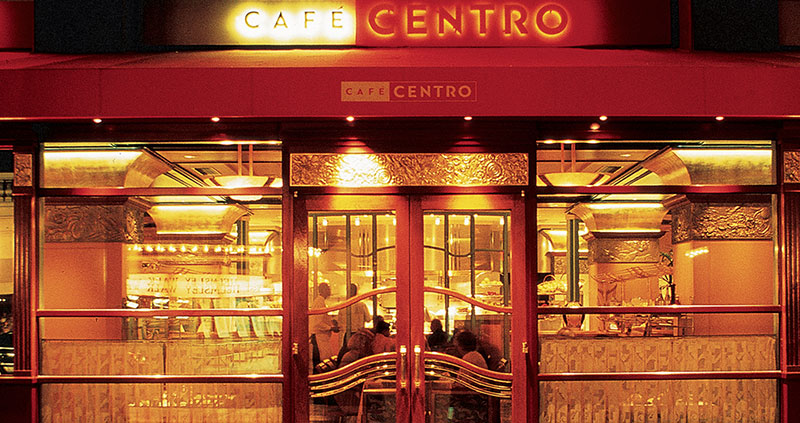
Looking
at
that gorgeous, glittering façade above,
you would hardly believe it’s inside the lobby
of the Met Life building, which New Yorkers
still call the Pan Am building. It
looks just like one of the more soigné
brasseries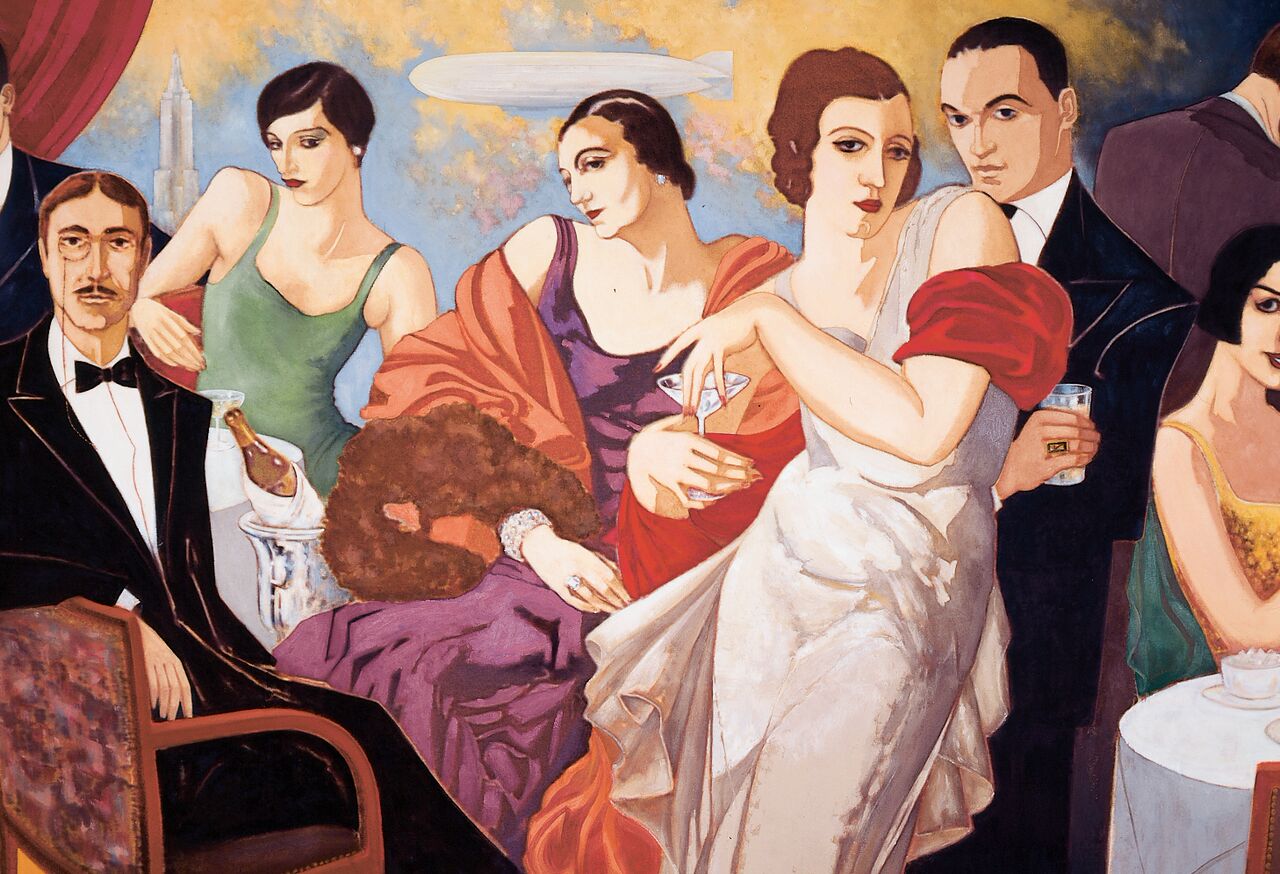 on
Boulevard Saint Germain, and, once
inside, you’ll be dazzled by the art deco
appointments and polish of the place—the lacy
curtains, glowing chandeliers, brown leather
booths, and a mural (left) in the style of Tamara
de Lempicka. There’s
also a genuine bonhomie provided by a cordial
wait staff.
on
Boulevard Saint Germain, and, once
inside, you’ll be dazzled by the art deco
appointments and polish of the place—the lacy
curtains, glowing chandeliers, brown leather
booths, and a mural (left) in the style of Tamara
de Lempicka. There’s
also a genuine bonhomie provided by a cordial
wait staff.
In a favorite brasserie or
bistro, if you order a dish you’ve had a hundred
times and it is good, you are happy; if it is bad,
you are sad; but when it is very, very
good, you are as delighted as the first time you
fell in love with it. That is the way it is with
Christina Towers’s food, which shows enormous
reverence for and knowledge of French brasserie fare
while imbuing it with her own personality. In so
many dishes the intensity of flavors and
reductions is the antithesis of cooking that can
so easily become staid. So, when you taste
Towers’s onion soup gratinée
($14), not only is the broth mahogany rich and
caramelized by the onions but the Gruyère and
Emmenthaler topping is just thick enough and
browned enough to insure it does not overwhelm the
soup and yet has the proper stringy texture
throughout (left).
fare
while imbuing it with her own personality. In so
many dishes the intensity of flavors and
reductions is the antithesis of cooking that can
so easily become staid. So, when you taste
Towers’s onion soup gratinée
($14), not only is the broth mahogany rich and
caramelized by the onions but the Gruyère and
Emmenthaler topping is just thick enough and
browned enough to insure it does not overwhelm the
soup and yet has the proper stringy texture
throughout (left).
Towers
(right)
studied at Le Cordon
Bleu and became chef de tournant at Rosemary’s
in Las Vegas, then sous-chef at New York Palace
and really fine-tuned her kitchen management
skills as executive sous chef under the Chef
Julien Jouhannaud at Le Bilboquet in NYC.
You can watch her through
a wide glass kitchen window working the stoves and
directing her cooks with the efficiency demanded
of a restaurant that does breakfast, a big lunch
and has a rush of people pouring in at six
o’clock.
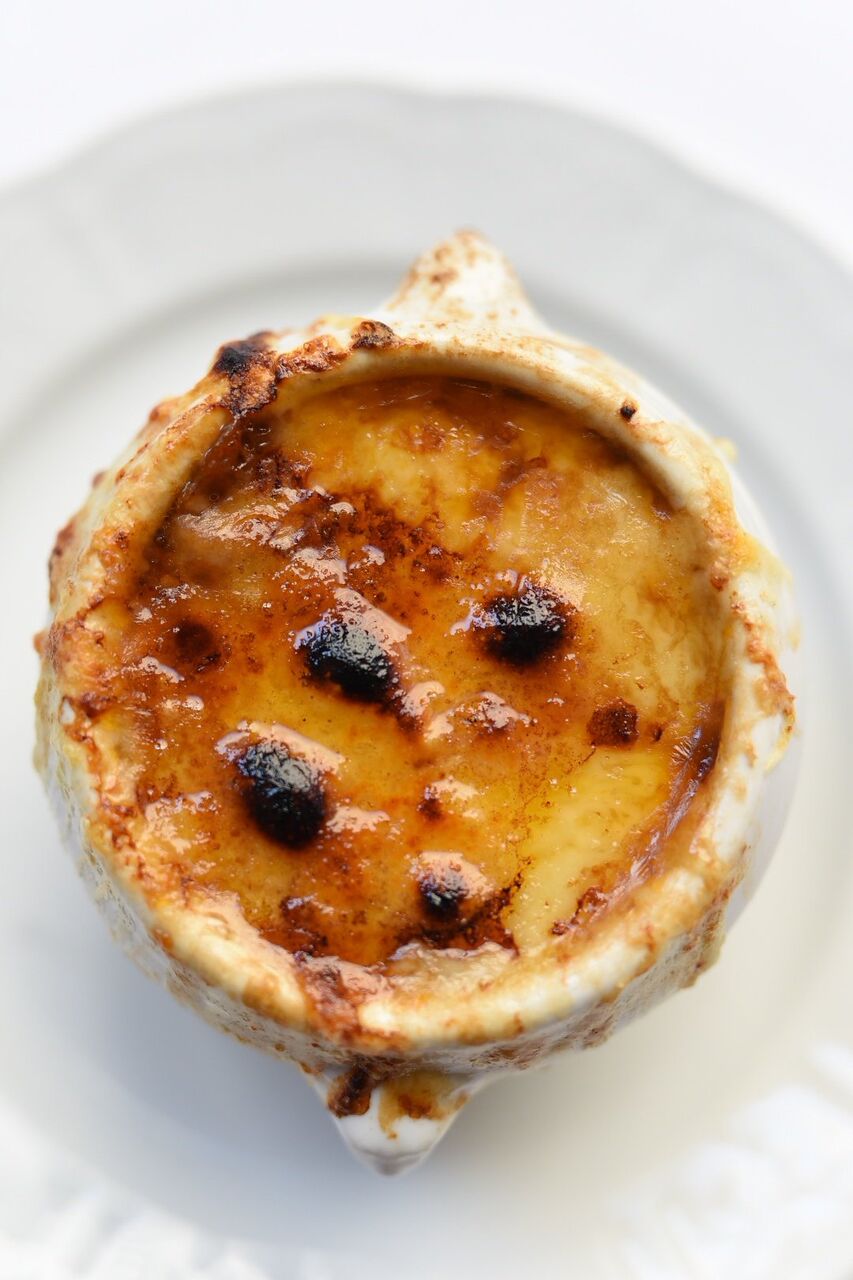 You might
begin with a generous plateau of seafood ($32 and
$49) or the pan-seared octopus with a tender bean
salad and lemon aïoli ($24). Beef
carpaccio with arugula and shaved Parmigiano was
delicately wrought and perfectly seasoned ($27). Parisian-style
gnocchi can so often be a Gallic mis-step of
floury, gummy tastelessness, but Towers’ version
is excellent, the gnocchi nicely formed, cuddled
in a ceramic dish and enriched with truffle butter
($16).
You might
begin with a generous plateau of seafood ($32 and
$49) or the pan-seared octopus with a tender bean
salad and lemon aïoli ($24). Beef
carpaccio with arugula and shaved Parmigiano was
delicately wrought and perfectly seasoned ($27). Parisian-style
gnocchi can so often be a Gallic mis-step of
floury, gummy tastelessness, but Towers’ version
is excellent, the gnocchi nicely formed, cuddled
in a ceramic dish and enriched with truffle butter
($16).
There are plats du jour—Monday,
coq au vin
($26), Tuesday, baked flounder ($29), Wednesday, osso buco
($36), Thursday, chicken paillard ($26), Friday,
bouillabaisse ($33) and Saturday, châteaubriand
for two ($39 per person). I was there on Monday
and lucky to sample the coq au vin in its dark, winey
reduction as rich as soup, with carefully cooked
chicken, carrots, pearl onions, mushrooms, mashed
potatoes and the requisite lardoons that really
make this dish so satisfying these wintery days.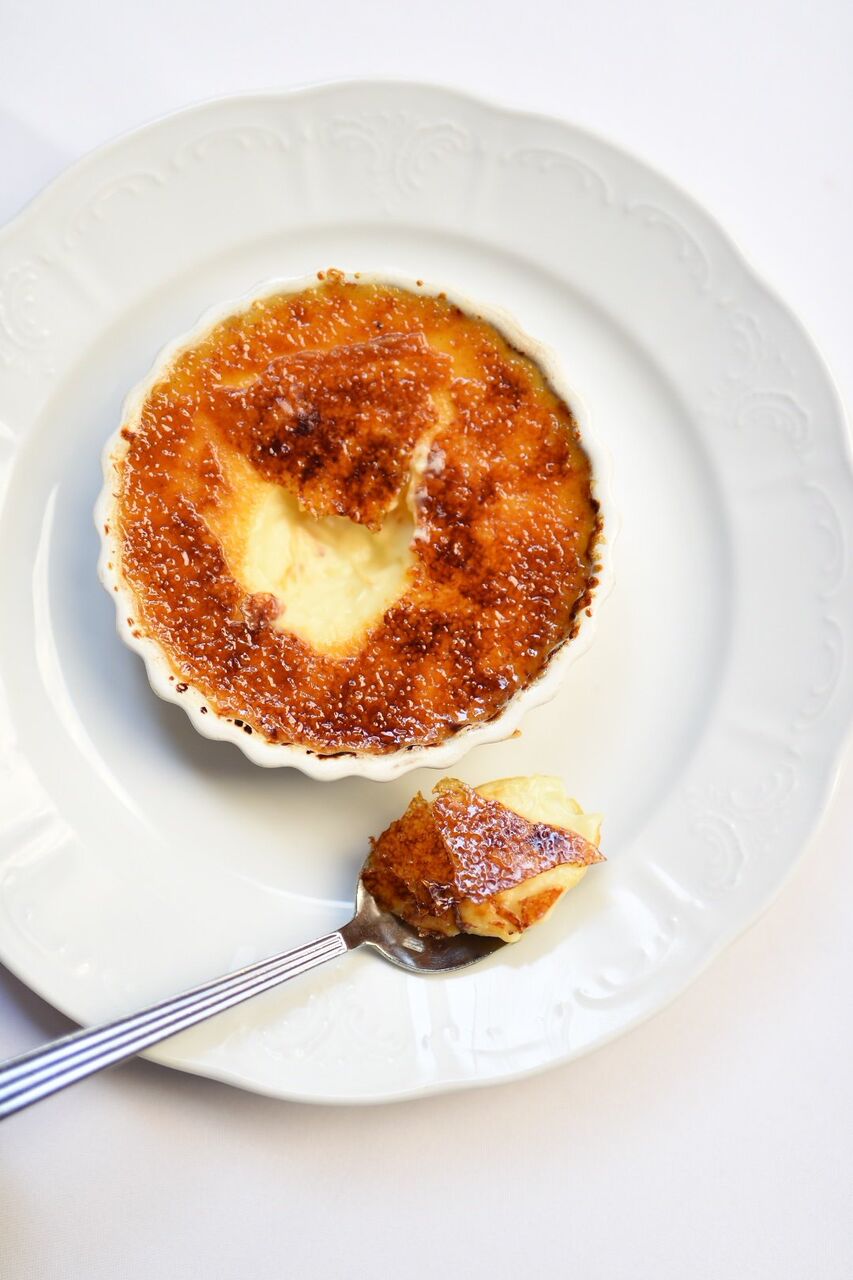
A simple steak au poivre
($45) was good, though it could have used a bit
more pepper bite, but the frites were
perfect. A
wild branzino
was superb, delicately roasted with delicious
eggplant caviar, bits of tomato and crispy
artichokes ($34). Unexpected was a lamb tagine
with couscous, toasted almonds, sweet dates and
carrots ($27), a North African dish as good as any
I’ve had around town.
Equal commitment is given to
desserts, with a crème brûlée (right) whose
crystallized crust shatters to reveal a wonderful
yellow interior of just the right creaminess. Cheesecake
was good, too, and I was happy to see an
old-fashioned American dessert—red velvet
cake—make it onto the menu.
Café Centro has a good
selection of wines by the glass ($13-$16), a
“sommelier’s selection” of bottlings chosen “for
their prized attributes and seasonal qualities,”
signature cocktails and a slew of bottled and
draft beers.
NYC doesn’t have quite the
number of bistros and brasseries it used to, and
even at some of the better ones, the kitchens seem
to be coasting. At Café Centro you can tell that
Christina Towers is very much a dynamic force, not
just making sure things taste right but putting
her own stamp on every dish that goes out of her
kitchen.
Open for breakfast and lunch, Mon.-Fri., dinner Mon.-Sat.
❖❖❖
TRUTH ABOUT SEAFOOD:
An Interview with Matthew Dolan
By John Mariani

Q. How does your new book differ from other seafood books?
 A: Simply Fish
adds in to each recipe a component of “what to ask
the fish guy.” Food insecurity is a real issue as
it pertains to all levels of consumers, and even
those fish lovers that only order fish at
restaurants won’t cook fish at home for a litany
of reasons: they don’t know how to handle it, they
don’t want the mess, and they don’t want their
Manhattan apartment to stink of fish for days. In
each recipe, I encourage folks to make the fish
counter do the dirty work for you. If followed,
the fish is pan ready with nominal to zero waste,
and the experience of cooking fish at home is made
a lot more pleasant.
A: Simply Fish
adds in to each recipe a component of “what to ask
the fish guy.” Food insecurity is a real issue as
it pertains to all levels of consumers, and even
those fish lovers that only order fish at
restaurants won’t cook fish at home for a litany
of reasons: they don’t know how to handle it, they
don’t want the mess, and they don’t want their
Manhattan apartment to stink of fish for days. In
each recipe, I encourage folks to make the fish
counter do the dirty work for you. If followed,
the fish is pan ready with nominal to zero waste,
and the experience of cooking fish at home is made
a lot more pleasant.
Q: Sustainability is key to your book. Is the current supply of seafood dwindling because of worldwide consumption?
A: The current supply of
seafood is well supported. The Monterey Bay
Aquarium, NOAA,  Scripps
Oceanographic Institute, and the Marine
Stewardship Council have been instrumental in
ensuring our awareness. The real issue is our
dependence on the common-demand species – salmon,
tuna, and shrimp. If we could create a demand for
the mesopelagic species (lantern fish for example,
and these other fishes that are deep water species
and there currently isn’t a demand for said
species in restaurants or markets), then we
could ease off of the demand for the overly
taxed species like salmon and tuna. This is wildly
optimistic. As a restaurateur, I must meet the
demand of my guests, and therefore we arrive at
this puzzling reality of how can we actually
promote a sustainable future?
Scripps
Oceanographic Institute, and the Marine
Stewardship Council have been instrumental in
ensuring our awareness. The real issue is our
dependence on the common-demand species – salmon,
tuna, and shrimp. If we could create a demand for
the mesopelagic species (lantern fish for example,
and these other fishes that are deep water species
and there currently isn’t a demand for said
species in restaurants or markets), then we
could ease off of the demand for the overly
taxed species like salmon and tuna. This is wildly
optimistic. As a restaurateur, I must meet the
demand of my guests, and therefore we arrive at
this puzzling reality of how can we actually
promote a sustainable future?
There is no lack of sustainable
seafood that exists in the wild; what we lack is a
thoughtful approach to consumption. The market
requires a populated list of recognizable fish,
the fisheries work tirelessly to meet this demand,
and sustainability too often becomes an
afterthought. Fortunately, there are lots of great
folks working hard to create a much needed
paradigm shift.
 Q: Is fish farming the
answer, and why is so much farmed fish inferior?
Q: Is fish farming the
answer, and why is so much farmed fish inferior?
A: Fish farming is not
the answer. And I know that my reply to this
question is massively unpopular, but I do not
care. Fish farms, not all but many, create ground
water issues, foster unnatural feed systems where
chicken has something to do with it (and the last
time I checked, fish don'T’t normally eat
chicken).
That said, there are some very
forward thinking fish farms that do not have a
negative impact. In California, the McFarland
Springs Trout (below)
from Kenny Belov sets a proper standard and
produces a wonderful, thoughtful, and sustainable
product.  My
singular point is that we need to protect these
species and commit to taking what is reasonable.
And while doing so, we need to lessen our
dependence on certain species. Before big boats,
big machines, and over-sized nets, we had rods and
reels. We need to support those that realize this,
are stewards of the sea, and care for the holistic
reality of what they are reaping for our
consumption. Fish farms make as much sense to me
as aquatic cattle ranches. I am not an expert, but
alas, you asked the question. I expect many
contrary opinions to follow this reply.
My
singular point is that we need to protect these
species and commit to taking what is reasonable.
And while doing so, we need to lessen our
dependence on certain species. Before big boats,
big machines, and over-sized nets, we had rods and
reels. We need to support those that realize this,
are stewards of the sea, and care for the holistic
reality of what they are reaping for our
consumption. Fish farms make as much sense to me
as aquatic cattle ranches. I am not an expert, but
alas, you asked the question. I expect many
contrary opinions to follow this reply.
Q: Why does the seafood in Europe taste better—sometimes so much better—than the same species available here?
A: As someone who went to high
school for a brief moment in Europe, married a
European, and holds a foundation of European
technique as the basis of the daily professional
endeavor, I think that what we experience when
traveling is less commercial than what we see here
in the U.S. My meaning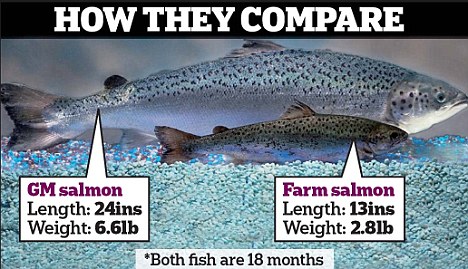 is that these fish
dishes taste better because they are culturally
entrenched. It’s not some culinary school graduate
who is trying something out for the first time,
most likely we are tasting something that has a
rooted history, has been well practiced and
executed, and comes from the local market – so
never frozen, never stored for long, and cooked
with a timeless sensibility that embraces a
cultural and historical respect for the product. That said, I
once had Eric Ripert’s fish in New York, and
herein lies the exception to the rule, as he and
many other chefs in the U.S. can execute at that
same level. When in Europe, we have set our stress
aside, hopefully, and we have opened our minds to
total enjoyment when it comes to dining. I will
say that the engrained culture of cooking and
respecting the core ingredients has a lot do with
the experience.
is that these fish
dishes taste better because they are culturally
entrenched. It’s not some culinary school graduate
who is trying something out for the first time,
most likely we are tasting something that has a
rooted history, has been well practiced and
executed, and comes from the local market – so
never frozen, never stored for long, and cooked
with a timeless sensibility that embraces a
cultural and historical respect for the product. That said, I
once had Eric Ripert’s fish in New York, and
herein lies the exception to the rule, as he and
many other chefs in the U.S. can execute at that
same level. When in Europe, we have set our stress
aside, hopefully, and we have opened our minds to
total enjoyment when it comes to dining. I will
say that the engrained culture of cooking and
respecting the core ingredients has a lot do with
the experience.
Q: If one doesn’t have access to a fish market or store, what are the key ways to get good seafood at supermarkets?
A: Although the common thread is that Whole Foods markets may be overpriced, they do carry only MSC-certified fish. That is huge. Another way is to download the Seafood Watch App and reach out to local wholesalers. Ask for a will-call order, select from the “Best Choice” category, and get in the car and go pick it up. This doesn’t take a ton of time and if you are polite and grateful for their time, they will work with you.
Q: What species are
particularly prone to manipulation? Scallops?
Branzino? Dover sole?
A: Salmon and trout. The
demand is crazy and so is the way that some of
this is being farm raised. “Franken-Salmon,”
genetically modified salmon, and simply toxic
farm-raised salmon are part of our reality. I
firmly believe in the seasonally designated wild
options.
Q: I’ve become very suspicious of any seafood coming out of Southeast Asia. Am I overreacting to reports of filthy conditions?
A: As you should! The
farm-raised Indonesian prawns are garbage. We have
great skim net-caught Gulf of Mexico prawns that
support our domestic fisheries and are a superior
product. Yes, our stuff costs more money,
but why the hell are we buying the Asian product
and taking money away from our domestic fisheries?
And the farm-raised products coming from Asia are
seriously in question with regards to
sustainability, mercury, how the fisheries damage
the eco-system and the carbon footprint, to even
getting them here in the first place. Is the
environment toxic? Most likely it is. You are not
overreacting at all to the filthy conditions, as
these fisheries are loosely, if at all, regulated.
 WHAT I'M DRINKING NOW
WHAT I'M DRINKING NOWBy John Mariani
DOMAINE CARNEROS PINOT NOIR 2012 ($55)—This is 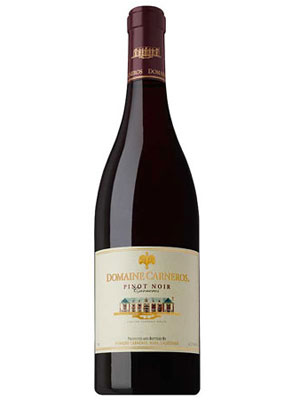 part of the domaine’s clonal
series, in this case Dijon 115, and it is
outstanding. Truly Californian in its structure,
with 14.4% alcohol, its five years of age has
pulled together all the elements that make Pinot
Noir elegant. It spent ten months aging in French
oak, just enough time to add a touch of caramel
flavor. An
ideal wine with a Christmas goose or loin of pork.
part of the domaine’s clonal
series, in this case Dijon 115, and it is
outstanding. Truly Californian in its structure,
with 14.4% alcohol, its five years of age has
pulled together all the elements that make Pinot
Noir elegant. It spent ten months aging in French
oak, just enough time to add a touch of caramel
flavor. An
ideal wine with a Christmas goose or loin of pork.
INMAN FAMILY OGV ESTATE PINOT NOIR
2012 ($73)—Another medium-bodied Pinot
Noir, this from Sonoma’s Russian River Valley,
where Pinots tend to run hotter. Winemaker
Kathleen Inman is clearly aiming for finesse,
using organic compost, careful clonal selection
and a cover crop that forces the grapes to work
harder for water, resulting in a smaller berry
with more concentration.
 GEORGES
DUBOEUF BEAUJOLAIS NOUVEAU 2017
($9)—The dwindling interest in celebrating
the midnight arrival of the unfinished wine
Beaujolais Nouveau and the opposing promotion of
fine aged Beaujolais has managed to demean Nouveau
wines as nothing more than a novelty. Which has
made top producers like Georges Duboeuf, the
so-called “King of Beaujolais,” re-think what used
to be little more than a watery purple beverage
for sipping with canapés. With
this 2017 vintage, Beaujolais Nouveau shows it can
have a pleasing body, cherry-like fruit and an
adaptability to all sorts of foods like chicken,
pork and, not least, salmon. It’s a damn good wine
for nine bucks.
GEORGES
DUBOEUF BEAUJOLAIS NOUVEAU 2017
($9)—The dwindling interest in celebrating
the midnight arrival of the unfinished wine
Beaujolais Nouveau and the opposing promotion of
fine aged Beaujolais has managed to demean Nouveau
wines as nothing more than a novelty. Which has
made top producers like Georges Duboeuf, the
so-called “King of Beaujolais,” re-think what used
to be little more than a watery purple beverage
for sipping with canapés. With
this 2017 vintage, Beaujolais Nouveau shows it can
have a pleasing body, cherry-like fruit and an
adaptability to all sorts of foods like chicken,
pork and, not least, salmon. It’s a damn good wine
for nine bucks.
DUTCHER CROSSING WINEMAKERS’ CELLAR
KUPFERSCHMID RED ($39)—The label is quite a
tongue twister; the wine is made by Debra Mathey
(who bought the estate in 2007) and winemaker
Kerry Danskey in Sonoma’s Dry Creek Valley. The
winery is named after a golden Labrador retriever
and they encourage a very laid back style that
welcomes visitors.
This is a blend of undisclosed grapes
(maybe some Grenache in there?) and for that it’s
both a curiosity piece and proof that blends not
in the sacrosanct California varietal mode can be
delicious.
DUSTED VALLEY MALBEC 2013 ($42)—The current interest in Malbec
is focused more on Argentina’s Mendoza Valley than
Washington State’s Columbia Valley, but here’s
proof the future looks good up there in Walla
Walla, although this is a little pricey. It’s got
a lighter body than Mendoza bottlings, and there’s
Cabernet Sauvignon  and a
touch of Petit Verdot blended in.
and a
touch of Petit Verdot blended in.
LOCK STOCK & BARREL 18 STRAIGHT
RYE WHISKEY ($230)—Produced by The Cooper
Spirits Co. to capitalize on the rush to rye, this
is the third in a series, following a 16-year aged
bottling. It
is double distilled from a rare mash of 100
percent rye grain, then a “robust cut" is
selected, which remains unfiltered and is then
aged in new charred American Oak barrels in cold
weather for 18 years and bottled at 109 proof. This
is one of the oldest ryes now on the market, true
to form in its heat bite and pleasant sweetness,
but there’s also a lot of spicy complexity and a
long, long time on the palate. Do note, however,
that it costs $230.

THE BLACK GROUSE ($27-$31)—Let those of us old
enough to remember a time when Single Malt
Scotches were both a rarity and curiosity stand to
applaud the scores of excellent blend whiskies
like Black Grouse (the UK’s best-selling brand)
that Scotch lovers enjoyed throughout the 20th
century. Indeed, Matthew Gloag founded the company
in 1800 and his Scotch came to be called “The
Famous Grouse.” It’s a very rich, layered Scotch
with a pronounced smokiness—there’s a good dose of
Islay Scotch blended in—and a lot of peat flavor. Incidentally,
when you buy a bottle, a donation of fifty pence
goes to the Royal Society for the Protection of
Birds, of which the native black grouse is in
decline.
❖❖❖

A single piece of a 12-year-old chocolate wedding cake
five feet high and weighing 200 pounds from Donald and
Melania Trump's wedding that cost $50,000 is up for
auction by Julie's Auctions.
COMING SOON: IDI AMIN AND ADOLPH HITLER!

On the eve of the death Charles Manson, Voodoo Doughnut in Portland, OR, created a tribute doughnut to the serial killer and
put a picture of it on Twitter.
Any of John Mariani's books below may be ordered from amazon.com.
 The
Hound in Heaven (21st Century Lion Books)
is a novella, and for anyone who loves dogs,
Christmas, romance, inspiration, even the supernatural, I
hope you'll find this to be a treasured favorite.
The story concerns how, after a New England teacher,
his wife and their two daughters adopt a stray puppy found
in their barn in northern Maine, their lives seem full of
promise. But when tragedy strikes, their wonderful dog
Lazarus and the spirit of Christmas are the only things
that may bring his master back from the edge of
despair.
The
Hound in Heaven (21st Century Lion Books)
is a novella, and for anyone who loves dogs,
Christmas, romance, inspiration, even the supernatural, I
hope you'll find this to be a treasured favorite.
The story concerns how, after a New England teacher,
his wife and their two daughters adopt a stray puppy found
in their barn in northern Maine, their lives seem full of
promise. But when tragedy strikes, their wonderful dog
Lazarus and the spirit of Christmas are the only things
that may bring his master back from the edge of
despair. WATCH THE VIDEO!
“What a huge surprise turn this story took! I was completely stunned! I truly enjoyed this book and its message.” – Actress Ali MacGraw
“He had me at Page One. The amount of heart, human insight, soul searching, and deft literary strength that John Mariani pours into this airtight novella is vertigo-inducing. Perhaps ‘wow’ would be the best comment.” – James Dalessandro, author of Bohemian Heart and 1906.
“John Mariani’s Hound in Heaven starts with a well-painted portrayal of an American family, along with the requisite dog. A surprise event flips the action of the novel and captures us for a voyage leading to a hopeful and heart-warming message. A page turning, one sitting read, it’s the perfect antidote for the winter and promotion of holiday celebration.” – Ann Pearlman, author of The Christmas Cookie Club and A Gift for my Sister.
“John Mariani’s concise, achingly beautiful novella pulls a literary rabbit out of a hat – a mash-up of the cosmic and the intimate, the tragic and the heart-warming – a Christmas tale for all ages, and all faiths. Read it to your children, read it to yourself… but read it. Early and often. Highly recommended.” – Jay Bonansinga, New York Times bestselling author of Pinkerton’s War, The Sinking of The Eastland, and The Walking Dead: The Road To Woodbury.
“Amazing things happen when you open your heart to an animal. The Hound in Heaven delivers a powerful story of healing that is forged in the spiritual relationship between a man and his best friend. The book brings a message of hope that can enrich our images of family, love, and loss.” – Dr. Barbara Royal, author of The Royal Treatment.
 |
The Encyclopedia of American Food and Drink by John F. Mariani (Bloomsbury USA, $35) Modesty forbids me to praise my own new book, but let me proudly say that it is an extensive revision of the 4th edition that appeared more than a decade ago, before locavores, molecular cuisine, modernist cuisine, the Food Network and so much more, now included. Word origins have been completely updated, as have per capita consumption and production stats. Most important, for the first time since publication in the 1980s, the book includes more than 100 biographies of Americans who have changed the way we cook, eat and drink -- from Fannie Farmer and Julia Child to Robert Mondavi and Thomas Keller. "This book is amazing! It has entries for everything from `abalone' to `zwieback,' plus more than 500 recipes for classic American dishes and drinks."--Devra First, The Boston Globe. "Much needed in any kitchen library."--Bon Appetit. |
"Eating Italian will never be the same after reading John Mariani's entertaining and savory gastronomical history of the cuisine of Italy and how it won over appetites worldwide. . . . This book is such a tasteful narrative that it will literally make you hungry for Italian food and arouse your appetite for gastronomical history."--Don Oldenburg, USA Today. "Italian
restaurants--some good, some glitzy--far
outnumber their French rivals. Many of
these establishments are zestfully described
in How Italian Food Conquered the World, an
entertaining and fact-filled chronicle by
food-and-wine correspondent John F.
Mariani."--Aram Bakshian Jr., Wall Street
Journal.
"Equal parts
history, sociology, gastronomy, and just
plain fun, How Italian Food Conquered the
World tells the captivating and delicious
story of the (let's face it) everybody's
favorite cuisine with clarity, verve and
more than one surprise."--Colman Andrews,
editorial director of The Daily
Meal.com. "A fantastic and fascinating
read, covering everything from the influence
of Venice's spice trade to the impact of
Italian immigrants in America and the
evolution of alta cucina. This book will
serve as a terrific resource to anyone
interested in the real story of Italian
food."--Mary Ann Esposito, host of PBS-TV's
Ciao
Italia. "John Mariani has written the
definitive history of how Italians won their
way into our hearts, minds, and
stomachs. It's a story of pleasure over
pomp and taste over technique."--Danny Meyer,
owner of NYC restaurants Union Square
Cafe, The Modern, and Maialino.
|
 |
 |
 |
 |
 |
 |
 |
 |
 Everett Potter's Travel Report:
Everett Potter's Travel Report: 
 Eating Las Vegas
JOHN CURTAS has been covering the Las Vegas
food and restaurant scene since 1995. He is
the co-author of EATING LAS VEGAS – The 50
Essential Restaurants (as well as
the author of the Eating Las Vegas web site: www.eatinglasvegas.
He can also be seen every Friday morning as
the “resident foodie” for Wake Up With the
Wagners on KSNV TV (NBC) Channel 3 in
Las Vegas.
Eating Las Vegas
JOHN CURTAS has been covering the Las Vegas
food and restaurant scene since 1995. He is
the co-author of EATING LAS VEGAS – The 50
Essential Restaurants (as well as
the author of the Eating Las Vegas web site: www.eatinglasvegas.
He can also be seen every Friday morning as
the “resident foodie” for Wake Up With the
Wagners on KSNV TV (NBC) Channel 3 in
Las Vegas.

MARIANI'S VIRTUAL GOURMET
NEWSLETTER is published weekly. Editor/Publisher: John
Mariani.
Editor: Walter Bagley. Contributing Writers: Christopher Mariani,
Robert Mariani, Misha Mariani, John A. Curtas, Geoff Kalish, Mort
Hochstein, and
Brian Freedman. Contributing Photographer: Galina
Dargery. Technical Advisor: Gerry McLoughlin.
To un-subscribe from this newsletter,click here.
© copyright John Mariani 2017

